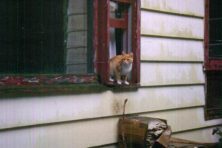Letter to the Editor: Washington Island Doesn’t Need More Cats
- Share
- Tweet
- Pin
- Share
Thank you, Door County Humane Society, for rescuing 40 cats from a hoarding situation on Washington Island. It is a relief for many to have this colony, one of several on the island, removed.
Trap/neuter/return (TNR) is a popular answer to the problem of abandoned and stray cats, but it carries with it considerable drawbacks.
First, consider the dangers to the cats themselves: parasites, disease, predation by other animals and even cruel humans, vehicle strikes, inclement weather. Exposing animals to these conditions is not a humane approach. Also colonies created through the TNR approach can still attract stray cats that are capable of reproducing.
Second, releasing cats to the outdoors can create a public health risk. Cats can carry several diseases that can be transmitted to humans, especially children and those with compromised immune systems. Toxoplasmosis is dangerous to pregnant women and children exposed to cat feces. (Think sand beaches, and sand boxes and playgrounds.) Other diseases include cat scratch fever, rabies and plague. The Mayo Clinic, Johns Hopkins, Cleveland Clinic, CDC, and national veterinary institutions offer more information on this subject.
Cat colonies can become attractive nuisances. Children especially can become attracted to the “kitties” that may unexpectedly scratch or bite. A feral cat is a wild animal.
Third, cats, a non-native species introduced by Europeans, are predators putting tremendous pressure on American wildlife. America’s estimated 150 million outdoor cats are killing birds by the billions – as well as mammals, reptiles, butterflies, etc. A study done by the Smithsonian’s Conservation Biology Institute and the U.S. Fish and Wildlife Service estimated between 1.4 to 3.7 billion birds are killed by cats each year. A University of Georgia and National Geographic Society study revealed 44 percent of cats are killers, those cats averaging one kill every 17 hours outdoors. Even if a cat only injures a bird the bird is unlikely to survive because of bacteria in the cat’s saliva. Hunting is a cat’s natural behavior – even well-fed cats will kill due to their instincts. More information about mortality of birds and animals can be found through publications by the institutions mentioned above, as well as the University of Minnesota and Wisconsin, and the extension offices of many other universities. Also refer to articles published by the Audubon Society, National Wildlife Federation, Cornell Laboratory of Ornithology, the American Bird Conservancy, and many other institutions. Read Cat Wars by Peter P. Marra and Chris Santella.
According to the American Bird Conservancy, the average life expectancy for an outdoor cat is two to five years; an indoor cat can live up to 15 years. Cats can be wonderful pets; love for our pets makes this subject an emotional issue. However, it does help to gain knowledge of the outcomes of TNR programs and the general consequences of releasing cats to the outdoors. We need to be considerate and make a safer environment for our pets, neighbors and wildlife.
Wendy Cooke
Washington Island, Wis.

